Why monuments?
 Bashny.Net
Bashny.Net
Why monuments?
To educate citizens, especially young people, a sense of pride in their ancestors, in their country, the willingness to defend it in arms in the attack of the enemy.
But for some reason now it is accepted to perpetuate beaten generals and titled martyrs.
And monuments should generate pride in their ancestors ...

He writes the author, Alexander B. Shirokorad
I was jarred from his childhood song, "we blew themselves" Korean "We sunk" Varyag ».
And as we have monuments "Varyag" and his commander Rudnev? Tens!
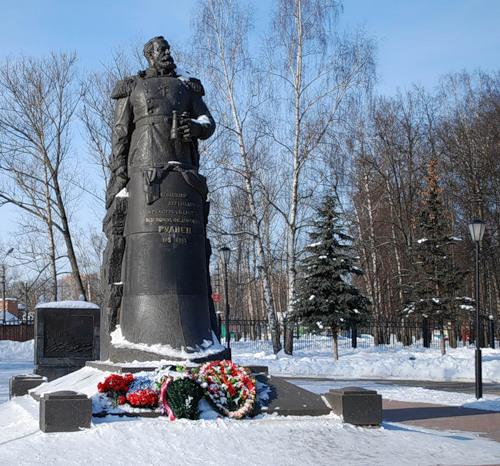
In the center of St. Petersburg monument destroyer "Guarding" - two sailors drowned as their boat. Sevastopol - monument to the scuttled ships. Novorossiysk - a monument of ships sunk in 1918 on the orders of Lenin, etc.
Now there are new sites. For example, in Sevastopol, a memorial plaque in honor of the sailors uvedshih ships from Sevastopol in November 1920. God's truth - competently led away: everything that could go - all 140 ships and nearly all sold successfully in 1921-1922. And with the battleships, cruisers and destroyers, which no one wanted to take, sold guns and ammunition, most of which in 1941 was in the hands of the Germans and Finns.
In my view, we must inspire our students that they are descendants of the victors, not the generals and broken titled martyrs. Let's go back to the same naval history. Where monuments Alexei Orlov, Having burnt the Turkish fleet at Cesme? Where monuments Potemkin - the creator of New Russia and the Black Sea Fleet?
HSH Prince Alexander G. Potemkin
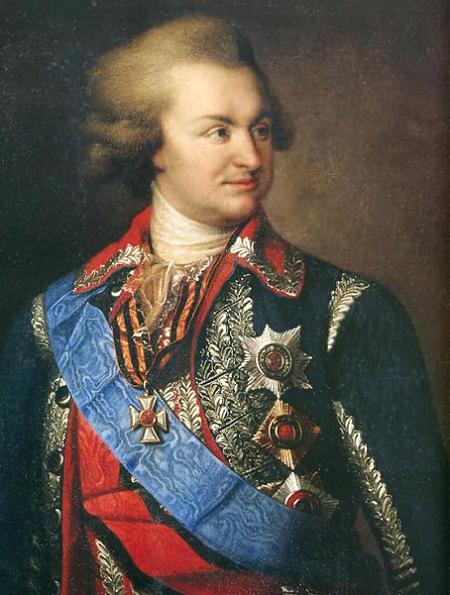
The criterion for the creation of a monument to a person must be a particular benefit the Russian state, not his political views, much less intimate life.
Why in London for a long time and there are monuments to Charles I and Oliver Cromwell? Second beheaded first, but the son of the king ordered take out from the grave the remains of Cromwell and send him to the gallows. But some sites are!
And how many in France and in Italy, Napoleon monuments, streets and squares named after him? Dozens, perhaps even hundreds! The cult of Napoleon is and will be in both countries, but Bonapartist party in France did not score a single percent of voters. Reasonable people in France are well aware that the thunder of Napoleon's victories - a "brand" of France.
Our rulers and artists do not understand this difference and death are against the construction of monuments of the Supreme Commander and the head of T-bills. But the monuments of beetles and other marshals - please, in any quantity. Following their logic, should demolish all the monuments to Peter the Great to erect monuments and Menshikov, Sheremetev, Apraksin and others. They are contrary to Peter de North won the war. And the king, they say, was "a beast on the throne" - thousands of executed musketeers, destroyed tens of thousands of Don and Zaporozhye Cossacks on the bones "Piterburh" built and the like.
The People's Commissar of Defense, Generalissimo of the Soviet Union Joseph Stalin

The country needs the monuments commanders and magistrates - winners such as Prince Svyatoslav. "I go to you" and "Dead shame no shame" should know each student.
Prince Svyatoslav. The monument by sculptor V. Klykova.
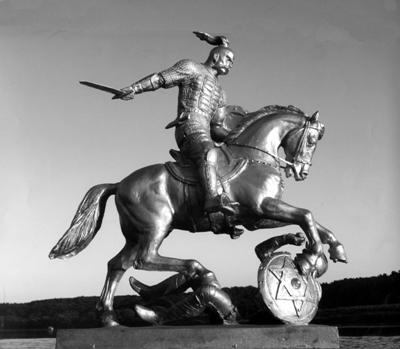
Why is there no monuments to our glorious ushkuynikov? They smashed the Norwegians to jelly sea, went to the Urals, killed tens of Tartar city on the Kama and Volga. Now some Kazan historians write about the "genocide of the Tatar people" committed by ushkuynikov. This, of course, brute force. But why not put the Astrakhan governor monument Prokop, with fifty eyelet passed with fights and who has taken the entire Volga Astrakhan? And the yard was in 1375, before the Battle of Kulikov was another five years.
Oh, Tatars offended ?! So it is time to remember that from 1250 to 1600 Russian Tatars more often fought side by side than against each other. Why not put a monument on the river Shelon Tatar cavalry, put an end to the dispute between Moscow and the Great Novgorod?
Is it not worthy monument Tatar prince Shig-Aley, under whose command the Russian army occupied Livonia in 1558? And note the victory of Russian arms and nose utrem Kazan separatists.
Not a sin to put a monument and Stepan Razin, but not the "leader of rebellious peasants," and the winner of the Shah of Persia. I myself read the angry letters of Peter I, I rebuke negligent commanders during the Persian campaign. Like, how many troops you have, and what are the results? How Razin with a few Cossacks beat the hordes of Persians!
Stepan Razin. Sculpture EV Vucetic
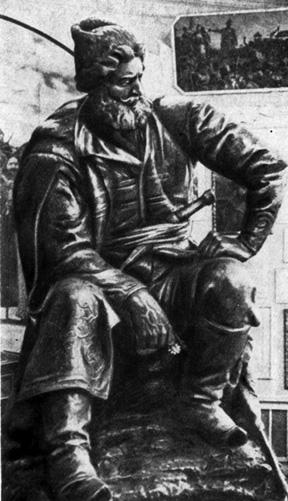
Completely forgotten in our hikes and the Don Cossacks in the Sinop, Trabzon, Istanbul and Varna. Moreover, the Zaporozhye Cossacks left to the orange Russophobia. And for what reason? The Cossacks never called themselves Ukrainians, but only the Russian people. They spoke only in Russian, and now in Kiev carefully translate their credentials to Ukrainian newspeak. Zaporozhye Cossacks in several waves since the end of XVIII to the middle of the XIX century migrated to the Kuban. Rhetorical question: whose are they "lytsar" - Russian or "Square»?
We have completely forgotten the hero of two Russian-Turkish wars (1768-1774 and 1787-1791 years) Greek corsair Lambros Kachonisa. This is his glorified Byron's poem "The Corsair". With Ushakov at the Black Sea fight only two-thirds of the Ottoman fleet, and a third unsuccessful Kachonisa caught in the Mediterranean Sea. Catherine the Great gave Lambros large plot of land in the Crimea. There he founded the settlement, naming it after his hometown of Livadia. But now about Kachonise not even know Livadia guides. A monument and a memorial will Kachonisu thousands of Greeks who died under Russian flags in the years 1769-1855.
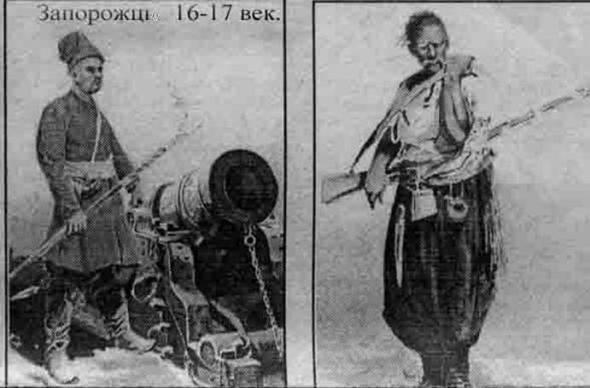
We have no monuments raid Caspian sailors to the Iranian port of Anzali in May 1920. But they returned the stolen white and British, and dozens of bulk transport vessels. These are ships that saved the Soviet republic from fuel starvation - because then communication Baku-Astrakhan was the only way to deliver oil. And at the same time our British man-of-war's man turnuli from the banks of the Caspian Sea by following the covenant of Nicholas I, who said that "never the British flag is not on the Caspian Sea».
Now instead of a monument to our sailors liberal historians poured their mud, calling adventurers, bandits, aggressors, etc.
It is time to once and for all resolve the question: what are the heroes of our young people need? Admirals-samotopy or dashing captains and chieftains, bringing terror to the enemy? Well, if one of them behaved somewhat incorrectly, let us turn to the experience of "enlightened navigators." Vaughan, England famous pirate Francis Drake and Admiral Horatio Nelson are the most important national heroes. And who of British schoolchildren know how this Horatio burned neutral Copenhagen and shot or burned alive thousands of prisoners Neapolitans?
Referring to the experience of the neighboring Poland. There's not a day goes by that CMI did not give biased material about the "Molotov - Ribbentrop Pact," Katyn or refusal Russian help in the Warsaw Uprising as if it happened only yesterday. Almost every Polish city of monuments dedicated to four thousand officers killed in Katyn. And we?
Smolensk land to the beginning of the XIV century and until 1919 many times subjected to invasions of the Poles and Lithuanians. But in the Smolensk region there are no monuments to hundreds of thousands of people who perished under the Polish sabers. But they built a magnificent memorial in Katyn, and preparing for the construction of a memorial to Mr. Kaczynski.
September 16, 1609 to June 3, 1611 that is 21 months, the city of Smolensk led an unequal struggle with the entire Polish-Lithuanian Commonwealth. Assistance was available from Smolensk. In September 1610 the Moscow boyars, headed by the Romanovs and let Saltykov Polish troops in the capital and the prince kissed the cross Vladislav. Throughout Russia fought one city.
And what happened September 16, 2009, the day of the 400th anniversary of the Smolensk Defense? Yes, absolutely nothing! Two weeks ago I was in Smolensk and ask local guides, will be celebrated June 3, 2011 - the 400th anniversary of the fall of the city? A: do not know, a penny for it is not released.
But a lot of money going to prepare for the celebration of the 1150th anniversary of Smolensk. Location And this date? It turns out that in the chronicles of the vocation Normans mentioned Smolensk. But many serious historians believe chronicles about calling Vikings fake. Above all else: cultural layers of the IX century in numerous excavations in Smolensk found. They begin with the 950's. Some historians suggest that the ancient Smolensk was in another place, for example, in the area Gnezdovo.
As you can see, anniversaries defense of Smolensk and the city's founding is not comparable in terms of its reliability and for its historical significance, I'm not talking about the "roundness" of dates. So let your inner-Smolensk celebrate the holiday, and the 400th anniversary of the Defense of Smolensk anniversary should be nation-wide. Suppose someone says that the 21-month defense of the city was not a model of courage and heroism!
The siege of Smolensk, the Poles in 1609-1611 gg. Engraving the beginning of the XVII century.
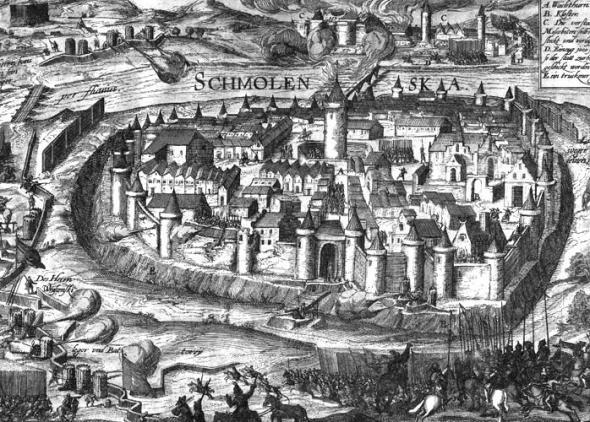
From the problems of ideological turn to purely technical. Across the country shot up on the pedestal of tanks and artillery pieces as monuments to the Great Patriotic War. This "cheap, but good."
And let them be even more. But weapons must match its time.

Thus, only in the Moscow region set on pedestals for more than 20 T-34/85 received by the Red Army from the end of 1944.
If the T-34's release of 1940-1942 have differences, notable only for a narrow circle of specialists, the replacement of the 76-millimeter guns on the 85-mm and installing another, much larger tower is visible even from a distance of 2-3 km.
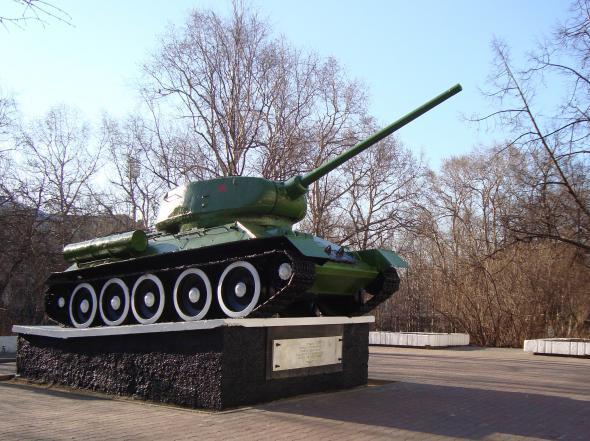
Almost all the "Katyusha", that is part of the artillery installation of M-13, are on pedestals in museums of Russia and CIS countries, delivered on cars ZIS-5 or on cars of release 1950.
In fact, the first "Katyusha" were installed on cars ZIS-6, whose production stopped in late 1941.
The last such unit is in the Artillery Museum in St. Petersburg.
Attempts to establish the M-13 on the ZIS-5 ended in the collapse of the chassis with the shooting.
During the war, artillery unit M-13 is set to "foreign cars" in the majority on all-terrain vehicles "Studebakers." Soviet ideologues believed that "Studebaker" - the wrong gear for so glorious of our arms.
So began a fake.

Now, in the age of the Internet, along with the entire apathetic morons we have enough and intelligent students. And little lie - forgery on monuments - causes great harm to the patriotic education of youth. Especially when the guides tell that this T-34/85 ... liberated town of Dmitrov, Kiev and Smolensk.

Serious problem now become inviolable Soviet-era monuments - concrete shore batteries, underground command posts and mines for intercontinental ballistic missiles, etc. Note that for the construction of a 305-millimeter battery dvubashennoy took over concrete, than the whole complex of the Dnieper. The distance between the tower is over 50 m. The towers were located on a huge concrete base - 130 m wide and 70 m to the sea. There, at a depth of 6 to 10 m, a three-meter concrete floor was a city with a diesel generator, air purification systems, showers, bathrooms, infirmary, and in Soviet times, and "Lenin room" (actually it is not a room, a huge hall). Shells and poluzaryady driving up from the cellars of the guns on the narrow-gauge railway. Lifting them and dosylka channel is fully automatic weapons.
Such batteries we've got four. Two of them are in a dilapidated condition at Cape Chersonese near Sevastopol in Fort Krasnaya Gorka on the southern shore of the Gulf of Finland. The first destroyed the Germans in 1942, and the second - on the orders of his Nikita Khrushchev in the early 1960s. But even two batteries - № 30 in Lyubimovka Sevastopol and "Voroshilov" on the island of Russian in Vladivostok - almost perfect preservation - even now can open fire. Battery number 30 by agreement with Ukraine will belong to us four decades. Now in full swing for sale to individuals over 20 Kronstadt forts that were built by Peter the Great. Forts have great historical value and represent a unique architectural monuments.
Dozens of concrete shore batteries scattered along the coast of the Kola Peninsula and in the throat of the White Sea. Dozens of such batteries are also in the Far East to the border with Korea to the Chukchi Peninsula. They abandoned the military. Looters partially removed metal structures, and partly they were perfectly safe because of the low availability.
Krondshtadsky fort "Alexander I» - much larger than the famous fort "Bayard", but much less known.

In addition to the "Pyramid of Cheops" of the Soviet era in Russia, there are dozens of giant concrete structures, created by the Germans and the Japanese.
For example, in 1941-1942 the Germans near Smolensk build a huge multi-storey underground Hitler's headquarters - "a bear's den."
But the Fuhrer "den" did not like, and there until the occupation of Smolensk by the Red Army was the command post of the army group "Center".
On the surface, leaving only concrete massive air intakes and outlets.
Now most of them are located in different owners - at the military unit of the Camp "Start" and then have dachnikov- "shestisotochnikov." Air intake - multimeter concrete cube - does not fit in one area: the territory of one half of the grower and the other half - the other. In any case, he ordered the FSB make entries in "bear den" and flood it with water.
Similarly, we dispense with other unique historical objects.
Victim of construction of the bridge to the island of Russian steel forts Vladivostok
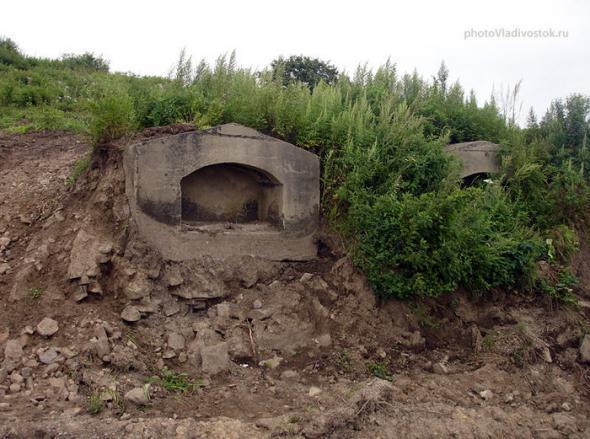
And what happens to similar facilities in Europe and America? There's shore batteries and forts of all time carefully preserved and become open-air museums. And, curiously, the content of the shore batteries not only places a heavy burden on the state budget, but on the contrary, guns and concrete bring good income tourism business.
Pay attention, it remains in many countries, not only of national relics, but also the former enemy shore batteries. It seems that the Norwegians were to remain painful memories of everything that is connected with the German occupation of 1940-1945 years. Nevertheless, the Norwegians turned into a museum the largest German coastal batteries, and again to get them considerable revenue.
German bunker in Guernsey (Guernsey). Photos of TravelWeekly, guide for tourists.
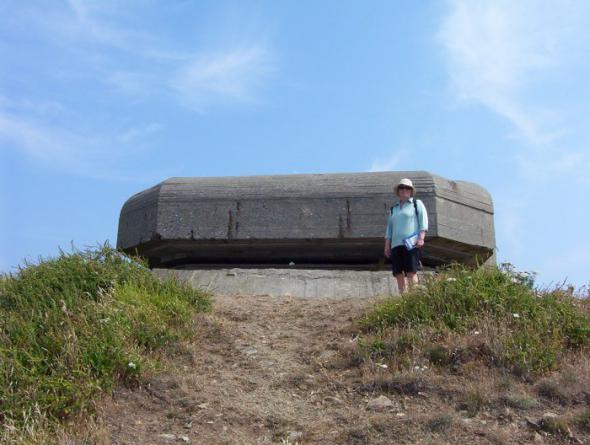
But residents of the British island of Guernsey in the English Channel in 1947, at the general meeting decided to demolish the 305-millimeter German battery "Mirus." By the way, the gun was in it with our battleship "Alexander III». The guns were sent to the metal, some of the concrete structures able to carry, and the majority of it remained. And now these ruins show tourists and locals curse their fathers for the blockhead.
The lesson we are Finns staged in Russian fortress Suomenlinna Museum. There remained intact Russian forts and dozens of guns caliber 280, 229 and 152 mm.
A natural question arises: why are these existing historical monuments do not tourist centers and not to receive them with currency, not to mention the patriotic education of youth? The answer is obvious. The problem is, when and who will get the judges currency. It's one thing when the currency will go to the state, a little, but for decades, and the other - when it goes to local officials directly and immediately. Here are sold under the historical monuments and manor houses of the "new nobility" and receive greenbacks and rosy on a silver platter.
In principle, the author is not against the sale of minor historical sites to private persons. But this should be done as it is done in Western Europe for decades. That is, the appearance should ideally be maintained, should be provided with regular access all the tourists who wish for a modest fee. So, gun casemates and towers must remain intact, and if repaired, only original materials. Well, let's say, in the barracks, warehouses and other outbuildings forts can organize and restaurants.

Of particular concern is the largest Russian artillery range - "Rzhevka" near St. Petersburg. There remained intact and in working-caliber gun Monster 406 and 356 millimeters, as well as dozens of the land and naval guns, made from mid-XIX at the end of the twentieth century. Polygon survived only because the officials of St. Petersburg and Leningrad region could divide it among themselves.
Source:
To educate citizens, especially young people, a sense of pride in their ancestors, in their country, the willingness to defend it in arms in the attack of the enemy.
But for some reason now it is accepted to perpetuate beaten generals and titled martyrs.
And monuments should generate pride in their ancestors ...

He writes the author, Alexander B. Shirokorad
I was jarred from his childhood song, "we blew themselves" Korean "We sunk" Varyag ».
And as we have monuments "Varyag" and his commander Rudnev? Tens!

In the center of St. Petersburg monument destroyer "Guarding" - two sailors drowned as their boat. Sevastopol - monument to the scuttled ships. Novorossiysk - a monument of ships sunk in 1918 on the orders of Lenin, etc.
Now there are new sites. For example, in Sevastopol, a memorial plaque in honor of the sailors uvedshih ships from Sevastopol in November 1920. God's truth - competently led away: everything that could go - all 140 ships and nearly all sold successfully in 1921-1922. And with the battleships, cruisers and destroyers, which no one wanted to take, sold guns and ammunition, most of which in 1941 was in the hands of the Germans and Finns.
In my view, we must inspire our students that they are descendants of the victors, not the generals and broken titled martyrs. Let's go back to the same naval history. Where monuments Alexei Orlov, Having burnt the Turkish fleet at Cesme? Where monuments Potemkin - the creator of New Russia and the Black Sea Fleet?
HSH Prince Alexander G. Potemkin

The criterion for the creation of a monument to a person must be a particular benefit the Russian state, not his political views, much less intimate life.
Why in London for a long time and there are monuments to Charles I and Oliver Cromwell? Second beheaded first, but the son of the king ordered take out from the grave the remains of Cromwell and send him to the gallows. But some sites are!
And how many in France and in Italy, Napoleon monuments, streets and squares named after him? Dozens, perhaps even hundreds! The cult of Napoleon is and will be in both countries, but Bonapartist party in France did not score a single percent of voters. Reasonable people in France are well aware that the thunder of Napoleon's victories - a "brand" of France.
Our rulers and artists do not understand this difference and death are against the construction of monuments of the Supreme Commander and the head of T-bills. But the monuments of beetles and other marshals - please, in any quantity. Following their logic, should demolish all the monuments to Peter the Great to erect monuments and Menshikov, Sheremetev, Apraksin and others. They are contrary to Peter de North won the war. And the king, they say, was "a beast on the throne" - thousands of executed musketeers, destroyed tens of thousands of Don and Zaporozhye Cossacks on the bones "Piterburh" built and the like.
The People's Commissar of Defense, Generalissimo of the Soviet Union Joseph Stalin

The country needs the monuments commanders and magistrates - winners such as Prince Svyatoslav. "I go to you" and "Dead shame no shame" should know each student.
Prince Svyatoslav. The monument by sculptor V. Klykova.

Why is there no monuments to our glorious ushkuynikov? They smashed the Norwegians to jelly sea, went to the Urals, killed tens of Tartar city on the Kama and Volga. Now some Kazan historians write about the "genocide of the Tatar people" committed by ushkuynikov. This, of course, brute force. But why not put the Astrakhan governor monument Prokop, with fifty eyelet passed with fights and who has taken the entire Volga Astrakhan? And the yard was in 1375, before the Battle of Kulikov was another five years.
Oh, Tatars offended ?! So it is time to remember that from 1250 to 1600 Russian Tatars more often fought side by side than against each other. Why not put a monument on the river Shelon Tatar cavalry, put an end to the dispute between Moscow and the Great Novgorod?
Is it not worthy monument Tatar prince Shig-Aley, under whose command the Russian army occupied Livonia in 1558? And note the victory of Russian arms and nose utrem Kazan separatists.
Not a sin to put a monument and Stepan Razin, but not the "leader of rebellious peasants," and the winner of the Shah of Persia. I myself read the angry letters of Peter I, I rebuke negligent commanders during the Persian campaign. Like, how many troops you have, and what are the results? How Razin with a few Cossacks beat the hordes of Persians!
Stepan Razin. Sculpture EV Vucetic

Completely forgotten in our hikes and the Don Cossacks in the Sinop, Trabzon, Istanbul and Varna. Moreover, the Zaporozhye Cossacks left to the orange Russophobia. And for what reason? The Cossacks never called themselves Ukrainians, but only the Russian people. They spoke only in Russian, and now in Kiev carefully translate their credentials to Ukrainian newspeak. Zaporozhye Cossacks in several waves since the end of XVIII to the middle of the XIX century migrated to the Kuban. Rhetorical question: whose are they "lytsar" - Russian or "Square»?
We have completely forgotten the hero of two Russian-Turkish wars (1768-1774 and 1787-1791 years) Greek corsair Lambros Kachonisa. This is his glorified Byron's poem "The Corsair". With Ushakov at the Black Sea fight only two-thirds of the Ottoman fleet, and a third unsuccessful Kachonisa caught in the Mediterranean Sea. Catherine the Great gave Lambros large plot of land in the Crimea. There he founded the settlement, naming it after his hometown of Livadia. But now about Kachonise not even know Livadia guides. A monument and a memorial will Kachonisu thousands of Greeks who died under Russian flags in the years 1769-1855.

We have no monuments raid Caspian sailors to the Iranian port of Anzali in May 1920. But they returned the stolen white and British, and dozens of bulk transport vessels. These are ships that saved the Soviet republic from fuel starvation - because then communication Baku-Astrakhan was the only way to deliver oil. And at the same time our British man-of-war's man turnuli from the banks of the Caspian Sea by following the covenant of Nicholas I, who said that "never the British flag is not on the Caspian Sea».
Now instead of a monument to our sailors liberal historians poured their mud, calling adventurers, bandits, aggressors, etc.
It is time to once and for all resolve the question: what are the heroes of our young people need? Admirals-samotopy or dashing captains and chieftains, bringing terror to the enemy? Well, if one of them behaved somewhat incorrectly, let us turn to the experience of "enlightened navigators." Vaughan, England famous pirate Francis Drake and Admiral Horatio Nelson are the most important national heroes. And who of British schoolchildren know how this Horatio burned neutral Copenhagen and shot or burned alive thousands of prisoners Neapolitans?
Referring to the experience of the neighboring Poland. There's not a day goes by that CMI did not give biased material about the "Molotov - Ribbentrop Pact," Katyn or refusal Russian help in the Warsaw Uprising as if it happened only yesterday. Almost every Polish city of monuments dedicated to four thousand officers killed in Katyn. And we?
Smolensk land to the beginning of the XIV century and until 1919 many times subjected to invasions of the Poles and Lithuanians. But in the Smolensk region there are no monuments to hundreds of thousands of people who perished under the Polish sabers. But they built a magnificent memorial in Katyn, and preparing for the construction of a memorial to Mr. Kaczynski.
September 16, 1609 to June 3, 1611 that is 21 months, the city of Smolensk led an unequal struggle with the entire Polish-Lithuanian Commonwealth. Assistance was available from Smolensk. In September 1610 the Moscow boyars, headed by the Romanovs and let Saltykov Polish troops in the capital and the prince kissed the cross Vladislav. Throughout Russia fought one city.
And what happened September 16, 2009, the day of the 400th anniversary of the Smolensk Defense? Yes, absolutely nothing! Two weeks ago I was in Smolensk and ask local guides, will be celebrated June 3, 2011 - the 400th anniversary of the fall of the city? A: do not know, a penny for it is not released.
But a lot of money going to prepare for the celebration of the 1150th anniversary of Smolensk. Location And this date? It turns out that in the chronicles of the vocation Normans mentioned Smolensk. But many serious historians believe chronicles about calling Vikings fake. Above all else: cultural layers of the IX century in numerous excavations in Smolensk found. They begin with the 950's. Some historians suggest that the ancient Smolensk was in another place, for example, in the area Gnezdovo.
As you can see, anniversaries defense of Smolensk and the city's founding is not comparable in terms of its reliability and for its historical significance, I'm not talking about the "roundness" of dates. So let your inner-Smolensk celebrate the holiday, and the 400th anniversary of the Defense of Smolensk anniversary should be nation-wide. Suppose someone says that the 21-month defense of the city was not a model of courage and heroism!
The siege of Smolensk, the Poles in 1609-1611 gg. Engraving the beginning of the XVII century.

From the problems of ideological turn to purely technical. Across the country shot up on the pedestal of tanks and artillery pieces as monuments to the Great Patriotic War. This "cheap, but good."
And let them be even more. But weapons must match its time.

Thus, only in the Moscow region set on pedestals for more than 20 T-34/85 received by the Red Army from the end of 1944.
If the T-34's release of 1940-1942 have differences, notable only for a narrow circle of specialists, the replacement of the 76-millimeter guns on the 85-mm and installing another, much larger tower is visible even from a distance of 2-3 km.

Almost all the "Katyusha", that is part of the artillery installation of M-13, are on pedestals in museums of Russia and CIS countries, delivered on cars ZIS-5 or on cars of release 1950.
In fact, the first "Katyusha" were installed on cars ZIS-6, whose production stopped in late 1941.
The last such unit is in the Artillery Museum in St. Petersburg.
Attempts to establish the M-13 on the ZIS-5 ended in the collapse of the chassis with the shooting.
During the war, artillery unit M-13 is set to "foreign cars" in the majority on all-terrain vehicles "Studebakers." Soviet ideologues believed that "Studebaker" - the wrong gear for so glorious of our arms.
So began a fake.

Now, in the age of the Internet, along with the entire apathetic morons we have enough and intelligent students. And little lie - forgery on monuments - causes great harm to the patriotic education of youth. Especially when the guides tell that this T-34/85 ... liberated town of Dmitrov, Kiev and Smolensk.

Serious problem now become inviolable Soviet-era monuments - concrete shore batteries, underground command posts and mines for intercontinental ballistic missiles, etc. Note that for the construction of a 305-millimeter battery dvubashennoy took over concrete, than the whole complex of the Dnieper. The distance between the tower is over 50 m. The towers were located on a huge concrete base - 130 m wide and 70 m to the sea. There, at a depth of 6 to 10 m, a three-meter concrete floor was a city with a diesel generator, air purification systems, showers, bathrooms, infirmary, and in Soviet times, and "Lenin room" (actually it is not a room, a huge hall). Shells and poluzaryady driving up from the cellars of the guns on the narrow-gauge railway. Lifting them and dosylka channel is fully automatic weapons.
Such batteries we've got four. Two of them are in a dilapidated condition at Cape Chersonese near Sevastopol in Fort Krasnaya Gorka on the southern shore of the Gulf of Finland. The first destroyed the Germans in 1942, and the second - on the orders of his Nikita Khrushchev in the early 1960s. But even two batteries - № 30 in Lyubimovka Sevastopol and "Voroshilov" on the island of Russian in Vladivostok - almost perfect preservation - even now can open fire. Battery number 30 by agreement with Ukraine will belong to us four decades. Now in full swing for sale to individuals over 20 Kronstadt forts that were built by Peter the Great. Forts have great historical value and represent a unique architectural monuments.
Dozens of concrete shore batteries scattered along the coast of the Kola Peninsula and in the throat of the White Sea. Dozens of such batteries are also in the Far East to the border with Korea to the Chukchi Peninsula. They abandoned the military. Looters partially removed metal structures, and partly they were perfectly safe because of the low availability.
Krondshtadsky fort "Alexander I» - much larger than the famous fort "Bayard", but much less known.

In addition to the "Pyramid of Cheops" of the Soviet era in Russia, there are dozens of giant concrete structures, created by the Germans and the Japanese.
For example, in 1941-1942 the Germans near Smolensk build a huge multi-storey underground Hitler's headquarters - "a bear's den."
But the Fuhrer "den" did not like, and there until the occupation of Smolensk by the Red Army was the command post of the army group "Center".
On the surface, leaving only concrete massive air intakes and outlets.
Now most of them are located in different owners - at the military unit of the Camp "Start" and then have dachnikov- "shestisotochnikov." Air intake - multimeter concrete cube - does not fit in one area: the territory of one half of the grower and the other half - the other. In any case, he ordered the FSB make entries in "bear den" and flood it with water.
Similarly, we dispense with other unique historical objects.
Victim of construction of the bridge to the island of Russian steel forts Vladivostok

And what happens to similar facilities in Europe and America? There's shore batteries and forts of all time carefully preserved and become open-air museums. And, curiously, the content of the shore batteries not only places a heavy burden on the state budget, but on the contrary, guns and concrete bring good income tourism business.
Pay attention, it remains in many countries, not only of national relics, but also the former enemy shore batteries. It seems that the Norwegians were to remain painful memories of everything that is connected with the German occupation of 1940-1945 years. Nevertheless, the Norwegians turned into a museum the largest German coastal batteries, and again to get them considerable revenue.
German bunker in Guernsey (Guernsey). Photos of TravelWeekly, guide for tourists.

But residents of the British island of Guernsey in the English Channel in 1947, at the general meeting decided to demolish the 305-millimeter German battery "Mirus." By the way, the gun was in it with our battleship "Alexander III». The guns were sent to the metal, some of the concrete structures able to carry, and the majority of it remained. And now these ruins show tourists and locals curse their fathers for the blockhead.
The lesson we are Finns staged in Russian fortress Suomenlinna Museum. There remained intact Russian forts and dozens of guns caliber 280, 229 and 152 mm.
A natural question arises: why are these existing historical monuments do not tourist centers and not to receive them with currency, not to mention the patriotic education of youth? The answer is obvious. The problem is, when and who will get the judges currency. It's one thing when the currency will go to the state, a little, but for decades, and the other - when it goes to local officials directly and immediately. Here are sold under the historical monuments and manor houses of the "new nobility" and receive greenbacks and rosy on a silver platter.
In principle, the author is not against the sale of minor historical sites to private persons. But this should be done as it is done in Western Europe for decades. That is, the appearance should ideally be maintained, should be provided with regular access all the tourists who wish for a modest fee. So, gun casemates and towers must remain intact, and if repaired, only original materials. Well, let's say, in the barracks, warehouses and other outbuildings forts can organize and restaurants.

Of particular concern is the largest Russian artillery range - "Rzhevka" near St. Petersburg. There remained intact and in working-caliber gun Monster 406 and 356 millimeters, as well as dozens of the land and naval guns, made from mid-XIX at the end of the twentieth century. Polygon survived only because the officials of St. Petersburg and Leningrad region could divide it among themselves.
Source:
Tags
See also
Biologist Jared diamond: Why do we like sex and why men
So why do we need these rivets on the jeans! And we are not even aware...
Why do you need to soak grains?
Stefan, cap'n: Why do we need universities?
You need to change in order to stay in the game
"Cabin Fever" in Finnish: a huge fleet, its forest
The "Eat and run" - as you need To run, to burn Pet snacks?
Do you need to think, to feel the warmth of the sun?
That's why you need to pierce the egg with a needle! Now, I do so always.
All New Year dishes in kilometers: as you need to run, not to recover.

















